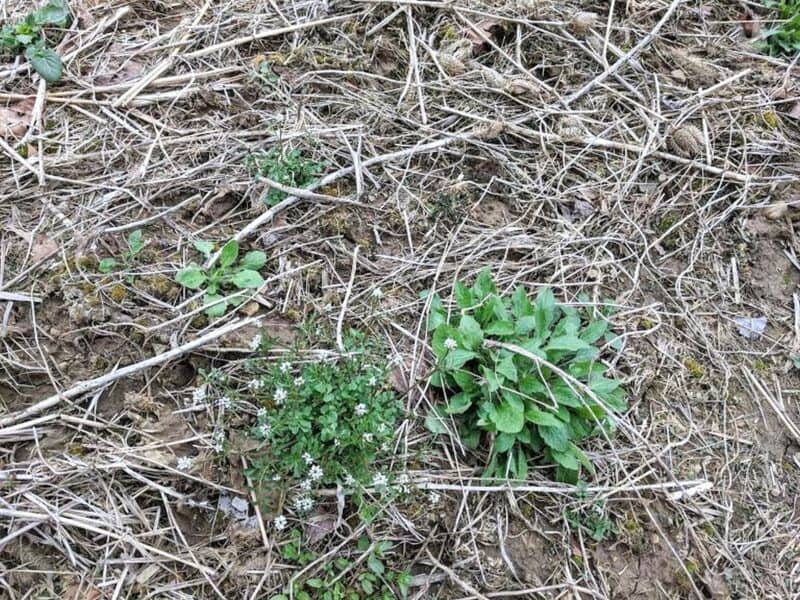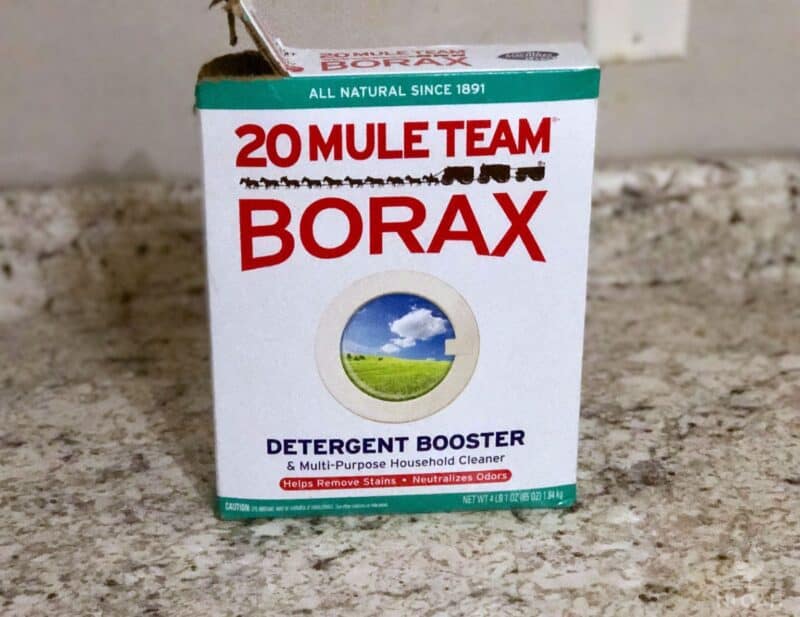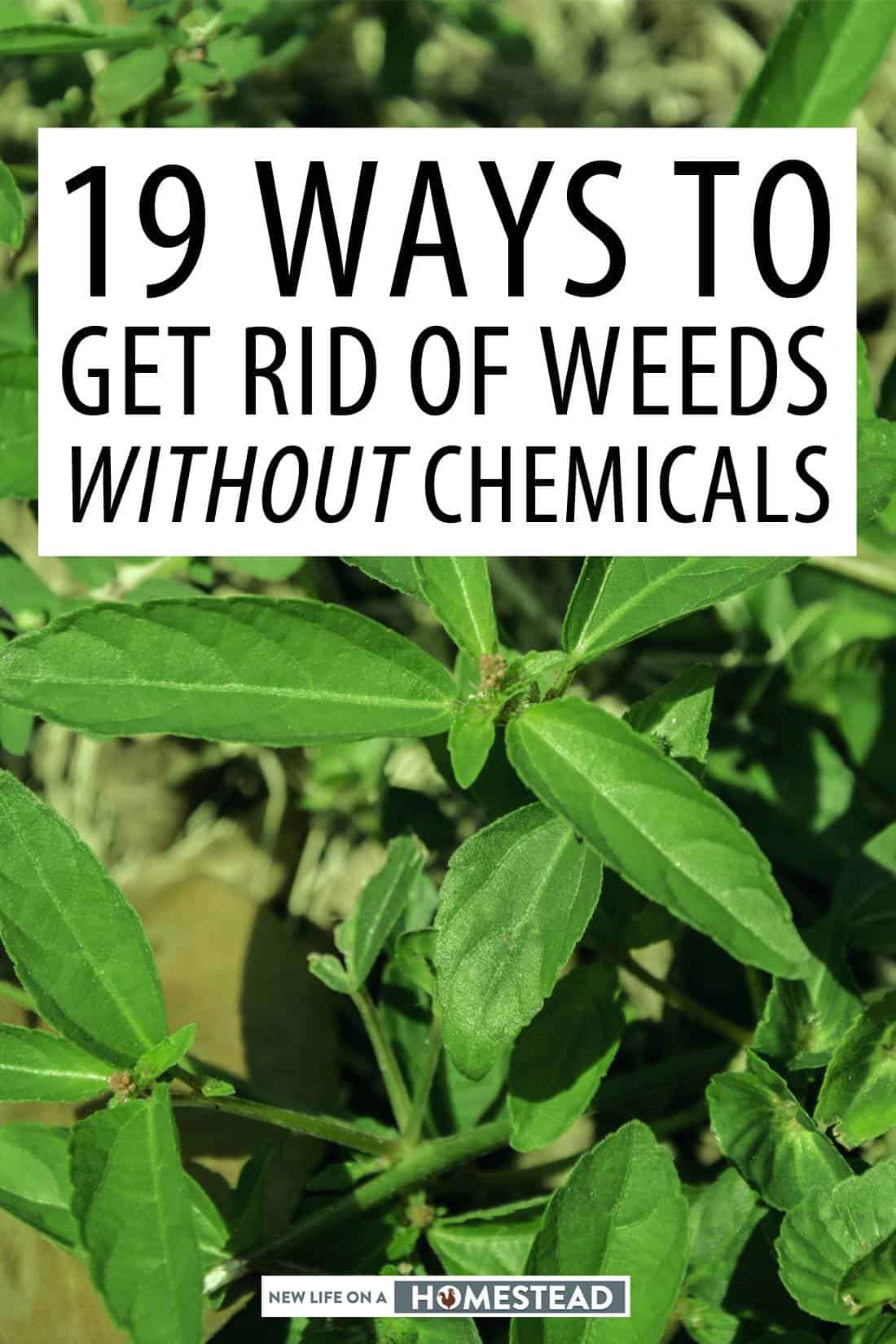No-one wants the hard work, money and energy that they have invested in creating a garden to be ruined by weeds.

It’s sometimes a temptation to go to the store and buy an environmentally friendly product that say it will eliminate the problem. But just as it isn’t necessary to use toxic chemicals to prevent weeds from growing in the garden, it isn’t necessary to spend a lot of money, either.
Before commercial weed killers became commonplace, a number of different weed control methods were chosen to deal with whichever type of weeds was in need of being controlled.
You need to identify the type of weeds you seek to control. Some weed plants are annuals, which only live for one season. Once they have set seed they die. Other weeds are perennial and return every year.
Whichever type of weed you wish to control, if you are not using chemical products, you will have to make their growing conditions unfavorable. So if you can prevent weeds from setting seed in the first place, this also provides the best, long-term control.
1. Weeding – Little and Often…
Nobody likes having to do weeding. There are so many more enjoyable activities and jobs to attend to in the garden! But the more frequently you attend to this task, the less time you will have to spend carrying out this chore.
By weeding weekly with a hoe or a trowel, you will reap the benefits and find this is an effective control for most weeds.
Cutting down or removing weeds when they are just small seedlings will prevent them from establishing themselves. Once they are established, they will have strong root systems, and will have become a long-term problem.
So, get out there, and begin weeding as soon as the weeds first appear. Push a sharp hoe such as a dutch hoe just under the soil surface. Do this when the weather is dry.
Don’t hoe any deeper because this can spread pieces of cut perennial weed roots through the soil where they will re-grow.
If there is any top growth which is dead or decaying, you should remove it. This will prevent the seeds of the weeds from spreading.
You will have to be very careful in small areas or in areas which are close to delicate plants. You will have to dig these weeds out carefully by hand, using a small hand-held trowel. This will make sure that you don’t harm any surrounding plants.
You need to decide whether you are going to work on removing weeds from a large area of your land or the weeds that are growing amongst your vegetables or lawn. Some of the methods described below are only suitable for large patches of weeds.
2. Try the No Dig Method
Not only is this method of gardening easier on your back but it can also bring many benefits. The more you turn over the soil, the more weed seeds will come to the surface of the soil. Try to disturb the soil as little as possible to avoid the growth of your plants.
So for example, maybe you can dig down just around the plants, rather than digging over the whole bed. The structure of the soil as well as the soil fertility will benefit from this limited approach and disturbance.
3. Light Deprivation
Weeds that receive no light will eventually die. Lack of sunlight will stop any weed seeds in the soil from sprouting, and will also kill off any low growing weeds.
So if you cover the weeds with landscape fabric, black plastic or a mulch, this will stop the light from reaching the weeds.
Cut the weeds down, and remove the debris before you cover the area with whatever material or mulch you have chosen.
If you have a large expanse such as a path or yard that you want to be weed free, you can simply suffocate the weeds which will successfully remove them.
To do this, you need to get hold of large panels of cardboard or several thicknesses of newspaper sheets. Place this over the area you want to treat and then add around 4 inches of mulch on top. Over time, the cardboard or paper will rot into your soil as it breaks down.
Spread wood or bark chips and other large-textured mulches 4 inches deep. If you are using a fine-textured mulch, such as leaf-mold or sawdust 2 inches deep.
Despite the covering, sometimes weeds do appear at the edges of the material or manage even to grow through mulches. Therefore, you need to check for and remove new weeds weekly, and top up mulches as they become less deep.
For even greater effect, if you spread a mulch over a fabric or plastic weed suppressant, you will achieve a longer-term result. The benefits of using a natural mulch (grass clippings, or wood chips) as a weed suppressant are not limited to killing off the weeds.
Providing the mulch is placed over the ground and is sufficiently thick, you will also find that it will slow down the rate of evaporation of water from the soil. It will also keep the ground cooler during the summer.
Remember not to pile mulches right up against young plants as this might cause the stems to rot.
4. Edging Material
Barriers, such as the retaining walls of raised beds, or lawn edging materials are long lasting solutions that will restrain weeds.
Decking boards are good choices since they are treated against rot. If you have any scrap lengths of decking timber, you can hammer them in the ground next to each other to for a barrier edging.
5. Control the Amount of Fertilizer and Water
Unfortunately, whenever you feed your plants, you are unwittingly also feeding the weeds! The same is true of water application. Often, you are applying more fertilizer and more water than your plants actually need.
And many plants, such as established shrubs and trees need very little in the way of extra water or nutrients. This is because they have well established root systems that are able to seek out moisture and feed from deep in the ground.
Annual plants, unlike perennials will need more in the way of feed and water as will your vegetables. Annuals have to grow quickly and produce foliage, flowers, fruits, and seeds, all in the course of one season so are demanding of fertilizer and water.
Many vegetables have extremely high water content so require copious amounts of nutrients and water to grow. Other vegetables, like root crops do not have the same requirements.
They can use their tap root to seek out water and feed from the soil. Armed with the information of which plants need food and water, and which do not, gives you the power to be selective in your applications.
6. Bring on the Sun
If you can trap the sun’s heat at the soil surface with clear plastic, then this will also kill weeds without having to resort to using harmful weed killers. Obviously, this is more achievable and effective in warm climates and during the summer months.
The heat of the sun also kills a range of pests as well as the weeds. To prepare the site, remove all plant top growth. Also, make sure there are no protruding rocks, clods of soil or anything else that will stop the plastic coming in contact with the soil.
Once you have laid the plastic on the ground, dig narrow trenches to secure the edges of the plastic and to stop it blowing away. Water the whole area until the soil is wet to a depth of 12 inches.
Place one edge of the plastic in one trench, then fill it in with soil. Lay the sheet of plastic over the whole area. Place the other side edge into the trench on the other side before also filling that side with soil.
Leave the plastic in place for four to six weeks. The heat of the sun on the soil will kill weed roots that are up to between 12 and 18 inches deep.
7. Competition is Good
Ground-cover plants are an alternative to weeds. Sometimes, they are also a very attractive option. Carefully selected ground cover plants will shade the weeds out with their leaves and stems.
First, remove the weeds, and plant the ground cover. Make sure you space the plants out according to their final growing dimensions. Spread mulch between them to keep weeds down while they get established.
Verbena “Imagination” is a trailing plant whose stems spread 12 to 24 inches (30 to 60 cm). It has pretty violet-blue, two inch flowers which appear above the well defined foliage in summer. This perennial plant is successful in U.S. Department of Agriculture plant zones from 9 to 10.
Foam flower (Tiarella cordifolia) also spreads the same sort of distance. This plant forms dense clumps of foliage and bears 10- to 12-inch spikes of tiny, white flowers in late spring. This plant will do best in USDA zones 4 to 9, and it will spread over time as it naturalizes.
8. Introduce some Goats!
Goats are a great option for any large areas where you need to clear unwanted vegetation. Their hooves also scarify (aerate) the soil as they graze. They are also a fairly cute addition to your garden.
However, goats are not discriminatory, and will decimate your garden of plants you want to keep if they gain access, so you will have to make sure they are penned in securely.
9. Cut your Grass!
Keeping your lawn mown regularly really helps to control the weeds that creep in and amongst your lawn grasses. If you keep the length to about 3 inches (7 cm), you will be able to prevent the weeds from setting seed. This will enable lawn grasses to thrive and the weeds to be choked out.
It’s worth noting however that mowing the weeds will not kill any perennial roots. Some of the annual weeds will also re-grow and attempt to flower. This is why it is imperative that you keep on top of the mowing for the whole season.
10. Boiling Water
A kettle of boiling water can be poured directly over weeds that are growing on a drive or in the cracks of paving or cemented areas. For additional economy, think of recycling your pasta water in this way instead of pouring it down the drain.
Boiling water will make the weeds shrivel. Because the water will cool as it runs off, there is little danger of the boiling water harming other plants.
11. Soap
Soap is a fat, and the oiliness contained in it will break down the surface of any weeds that have waxy or hairy leaves.
12. Vinegar and Salt
Any weed that has a long taproot, such as a dandelion can be removed by using vinegar. This is another effective method to deal with weeds that grow on your driveway or in the cracks.
The soil around the weed must be soaked with sufficient vinegar to reach the weed’s roots. It will take several days to take effect but in less than a week, your dandelions or docks will be no more.
Sometimes you throw away vinegar from empty jars of pickled onions, cornichons – so think of using this as a weed killer instead. You need to make sure that you only pour it at the base of the weeds, because you don’t want the vinegar to leach into the roots of any plants that are growing nearby.
Vinegar makes an even more effective weed killer when it is mixed with salt and washing up liquid. 1 gallon of vinegar can be mixed with 1 cup of salt and 1 tablespoon of washing up liquid. Pour the mixture into a spray bottle and you can target the weeds directly.
13. Salt
Salt has been used for centuries to prevent weeds from growing. However, it can have a harmful effect on the soil.
It is important that, if you are using salt as a weed killer, you only apply it directly to the leaves of the weeds you want to kill. Don’t soak the soil particularly in places where there are other garden plants.
The best way to do this is to dissolve 1 part salt in 3 parts of water and you can add a few drops of washing up liquid.
In a spray bottle, you can carefully spray the leaves of the weeds with the salt solution. Make sure that the leaves of any plants you want to keep are tied back, and several applications may be needed.
14. Borax
This is a very commonly available laundry cleaning product which is available in grocery stores. It comes in powdered form.
You can mix 10 ounces of borax with 2½ gallons of water. Once it has dissolved, you can use a sprayer to spray the leaves of weeds. Once again, it is important that you avoid spraying any plants you don’t want to destroy!

And, in addition, it is a good idea to try to avoid soaking the soil with a borax solution. You should also wear gloves because it is important to avoid contact of the product with your skin.
15. Burn, Burn, Burn
Typically, a weed burner is a lance which is attached to a gas propane tank. To use, you simply pass the flame over the weed plant. The plant tissue will be heated and the plant will die.
Unfortunately, whilst the weed burner is an effective tool to use to kill the top growth of weeds, it will not kill the roots. To achieve full results, you need to flame the weeds several times.
There is a fire risk attached to using a weed burner in a hot dry spell. And you need to make sure you follow all the safety instructions.
16. Corn Gluten Meal
This by product of the grain milling process is proven as an effective deterrent to prevent weeds from germinating. Sometimes, it is applied to garden lawns or other areas where weeds need to be controlled. This product is harmless to animals and an organic option is also available. If you cannot find it in your local garden store, then try ordering it online.
17. Give the Weeds Some Alcohol!
You can make an effective weedkiller mixing together 1 ounce of vodka, two cups of water, and a couple of drops of washing up liquid.
Although this doesn’t work well in shady areas, in sunny areas the vodka cocktail will dry out the weeds and they will die. Make sure you don’t spray onto any of your plants though, or the vodka will dry them out.
18. Eat them!
Some weeds such as purslane, yellow dock, chicory, clover, and dandelion leaves make great additions to your salads and are packed with nutrition.
Be warned though. Many, many plants are extremely poisonous. So never eat any plant unless you are absolutely sure it is safe to do so.
19. How About Geese?
If you don’t want the possibility of a flock of goats escaping from their pen and munching through your crops, you might consider allowing a few geese in. If your yard or garden is mainly grass, then geese might be well worth considering in order to provide effective weed control.
Young geese are able eat a huge percentage of their weight in grass or weeds but, in order to achieve that, they need access to the basics, such as water, shade and perhaps some extra feed. But, come Christmas…
Just two geese will be able to cope with an acre, though you’ll likely want more. The only word of caution is that geese love corn, so if it’s a corn field you want weeded, geese are not the ideal choice!
20. A Final Suggestion – Learn to Love Weeds!
Whilst the above ideas and methods to remove weeds are a more sustainable alternative to using harsh and poisonous chemicals, they are not without risk.
Because your garden plants are in danger of being killed off by the application of some of these products, there is also a potential risk to your soil, your garden and yourself. You should also try to avoid using any of these remedies in large quantities.
Remember that weeds are simply native plants that are growing where they are not wanted. They are hard to kill because they are intended to grow where they are growing!
Finally, don’t give up and remember that one person’s weed is someone else’s rose! So maybe you can learn to love your weeds, for that is the easiest option of them all.


Sally is a retired English lawyer who spent 20 years homesteading on the Welsh hillsides in the U.K.
Semi-retired, she moved to France 15 years ago, where she and her husband set about restoring a 14th century watermill which came with 5 hectares of woodland, riverbank, and pastureland.
Using the skills and experience gained in the U.K, they continue to enjoy working on their land, woods and water.
